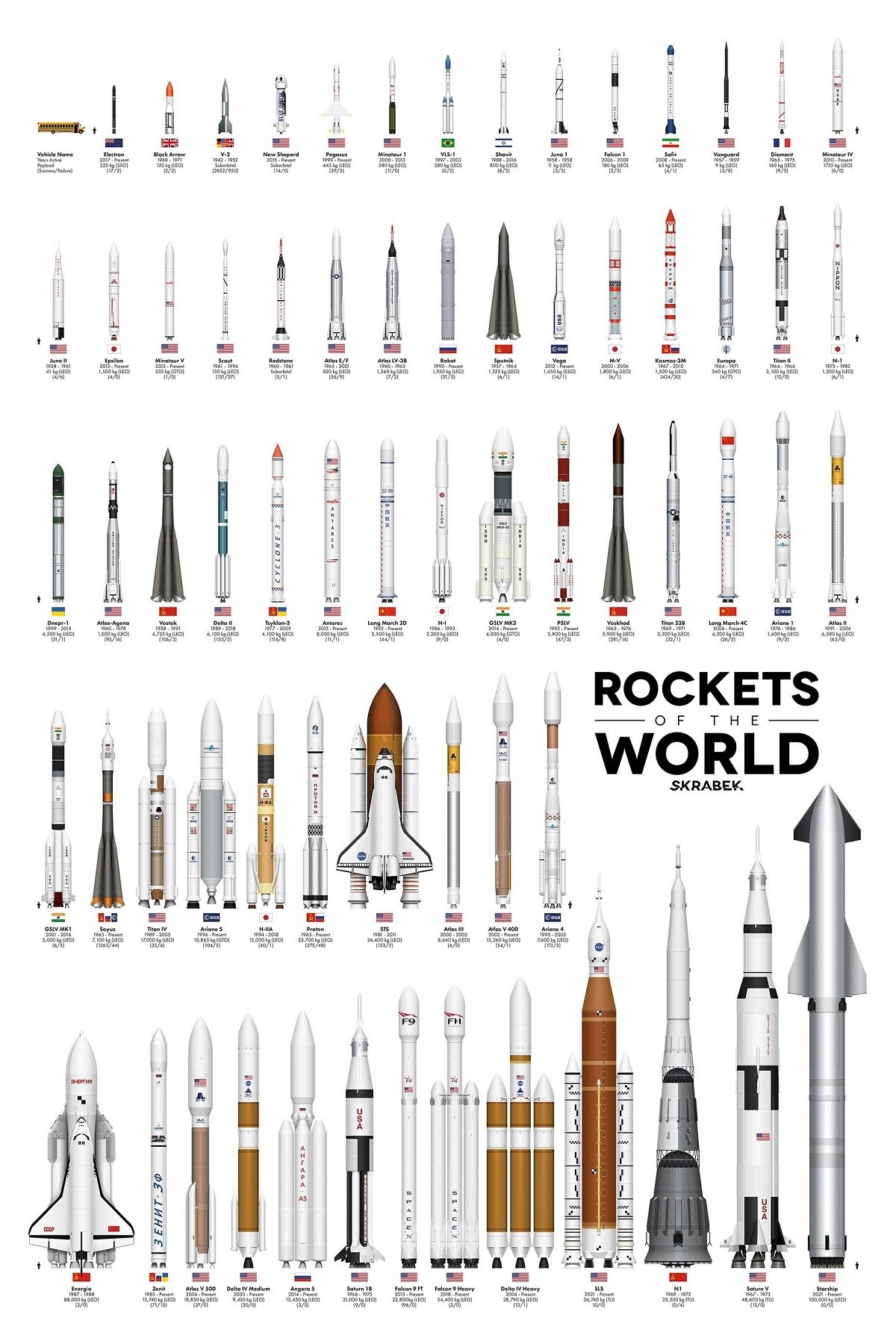The size and shape of the world's rockets from 1957 - now

Designer Tyler Skarbek has designed a visualization of the world's different rockets. Image: REUTERS/Steve Nesius
Omri Wallach
Reporter, Visual Capitalist
Get involved with our crowdsourced digital platform to deliver impact at scale
Stay up to date:
Emerging Technologies
- An infographic by designer Tyler Skarbek incorporates a comparison of the world's different rockets.
- It shows which country designed each rocket, what years they were used, and what they achieved.
- This piece takes a detailed look at when rockets first originated in the form of ballistic missiles, to the planned launch of the SpaceX Starship today.
- Rocket designs are expected to further develop as space exploration becomes more common.
The size of the world’s rockets, past and present
The SpaceX Starship might be the next rocket to take humans to the moon, but it won’t be the first, and likely not the last.
Starting in the mid-20th century, humanity has explored space faster than ever before. We’ve launched satellites, telescopes, space stations, and spacecrafts, all strapped to rocket-propelled launch vehicles that helped them breach our atmosphere.
This infographic from designer Tyler Skarbek stacks up the many different rockets of the world side-by-side, showing which country designed them, what years they were used, and what they (could) accomplish.
How do the world’s rockets stack up?
Before they were used for space travel, rockets were produced and developed to be used as ballistic missiles.
The first rocket to officially reach space—defined by the Fédération Aéronautique Internationale as crossing the Kármán line at 100 kilometers (62 miles) above Earth’s mean sea level—was the German-produced V-2 rocket in 1944.
But after World War II, V-2 production fell into the hands of the U.S., the Soviet Union (USSR), and the UK.
Over the next few decades and the unfolding of the Cold War, what started as a nuclear arms race of superior ballistic missiles turned into the Space Race. Both the U.S. and the USSR tried to be the first to achieve and master spaceflight, driving production of many new and different rockets.
To see all entries in the full interactive chart, click here.
As the Space Race wound down, the U.S. proved to be the biggest producer of different rockets. The eventual dissolution of the USSR in 1991 transferred production of Soviet rockets to Russia or Ukraine. Then later, both Europe (through the European Space Agency) and Japan ramped up rocket production as well.
More recently, new countries have since joined the race, including China, Iran, and India. Though the above infographic shows many different families of rockets, it doesn’t include all, including China’s Kuaizhou rocket and Iran’s Zuljanah and Qased rockets.
Rocket range explained and continued space aspirations
Designing a rocket that can reach far into space while carrying a heavy payload—the objects or entities being carried by a vehicle—is extremely difficult and precise. It’s not called rocket science for nothing.
When rockets are designed, they are are created with one specific range in mind that takes into account the fuel needed to travel and velocity achievable. Alternatively, they have different payload ratings depending on what’s achievable and reliable based on the target range.
- Suborbital: Reaches outer space, but its trajectory intersects the atmosphere and comes back down. It won’t be able to complete an orbital revolution or reach escape velocity.
- LEO (Low Earth orbit): Reaches altitude of up to ~2,000 km (1242.74 miles) and orbits the Earth at an orbital period of 128 minutes or less (or 11.25 orbits per day).
- SSO (Sun-synchronous orbit): Reaches around 600–800 km above Earth in altitude but orbits at an inclination of ~98°, or nearly from pole to pole, in order to keep consistent solar time.
- GTO (Geosynchronous transfer orbit): Launches into a highly elliptical orbit which gets as close in altitude as LEO and as far away as 35,786 km (22,236 miles) above sea level.
- TLI (Trans-lunar injection): Launches on a trajectory (or accelerates from Earth orbit) to reach the Moon, an average distance of 384,400 km (238,900 miles) from Earth.
But there are other ranges and orbits in the eyes of potential spacefarers. Mars for example, a lofty target in the eyes of SpaceX and billionaire founder Elon Musk, is between about 54 and 103 million km (34 and 64 million miles) from Earth at its closest approach.
What is the World Economic Forum doing about the Fourth Industrial Revolution?
With space exploration becoming more common, and lucrative enough to warrant billion-dollar lawsuits over contract awards, how far will future rockets go?
Don't miss any update on this topic
Create a free account and access your personalized content collection with our latest publications and analyses.
License and Republishing
World Economic Forum articles may be republished in accordance with the Creative Commons Attribution-NonCommercial-NoDerivatives 4.0 International Public License, and in accordance with our Terms of Use.
The views expressed in this article are those of the author alone and not the World Economic Forum.
Related topics:
The Agenda Weekly
A weekly update of the most important issues driving the global agenda
You can unsubscribe at any time using the link in our emails. For more details, review our privacy policy.
More on Emerging TechnologiesSee all
Juliana Guaqueta Ospina
April 11, 2024
Nikolai Khlystov and Gayle Markovitz
April 8, 2024
Simon Torkington
April 8, 2024
Victoria Masterson
April 4, 2024
Gareth Francis
April 3, 2024








